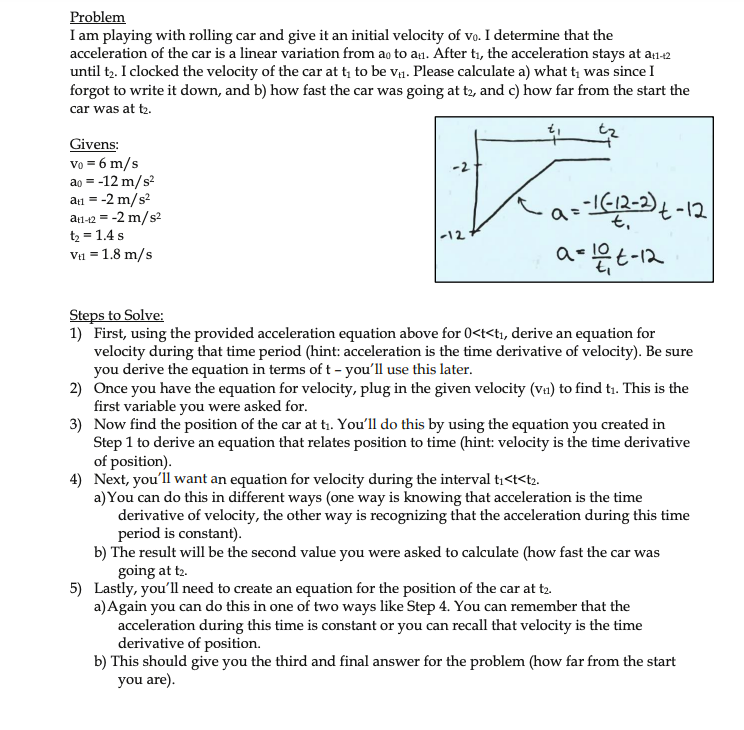Problem I am playing with rolling car and give it an initial velocity of vo. I determine that the acceleration of the car is a linear variation from ao to an. After t1, the acceleration stays at an1-2 until t2. I clocked the velocity of the car at t; to be va. Please calculate a) what t; was since I forgot to write it down, and b) how fast the car was going at t2, and c) how far from the start the car was at t2. Givens: Vo = 6 m/s ao = -12 m/s? an = -2 m/s² an-42 = -2 m/s2 t2 = 1.4 s -12 V1 = 1.8 m/s
Problem I am playing with rolling car and give it an initial velocity of vo. I determine that the acceleration of the car is a linear variation from ao to an. After t1, the acceleration stays at an1-2 until t2. I clocked the velocity of the car at t; to be va. Please calculate a) what t; was since I forgot to write it down, and b) how fast the car was going at t2, and c) how far from the start the car was at t2. Givens: Vo = 6 m/s ao = -12 m/s? an = -2 m/s² an-42 = -2 m/s2 t2 = 1.4 s -12 V1 = 1.8 m/s
Elements Of Electromagnetics
7th Edition
ISBN:9780190698614
Author:Sadiku, Matthew N. O.
Publisher:Sadiku, Matthew N. O.
ChapterMA: Math Assessment
Section: Chapter Questions
Problem 1.1MA
Related questions
Question
- Once answered correctly will UPVOTE!!

Transcribed Image Text:Problem
I am playing with rolling car and give it an initial velocity of vo. I determine that the
acceleration of the car is a linear variation from ao to an. After tı, the acceleration stays at a1-2
until t2. I clocked the velocity of the car at t to be va. Please calculate a) what t; was since I
forgot to write it down, and b) how fast the car was going at t2, and c) how far from the start the
car was at t2.
t2
Givens:
Vo = 6 m/s
ao = -12 m/s?
an = -2 m/s?
an-2 = -2 m/s?
tz = 1.4 s
Vu = 1.8 m/s
-12
Steps to Solve:
1) First, using the provided acceleration equation above for 0<t<ti, derive an equation for
velocity during that time period (hint: acceleration is the time derivative of velocity). Be sure
you derive the equation in terms of t – you'll use this later.
2) Once you have the equation for velocity, plug in the given velocity (va) to find t1. This is the
first variable you were asked for.
3) Now find the position of the car at tı. You'll do this by using the equation you created in
Step 1 to derive an equation that relates position to time (hint: velocity is the time derivative
of position).
4) Next, you'll want an equation for velocity during the interval ti<t<t2.
a) You can do this in different ways (one way is knowing that acceleration is the time
derivative of velocity, the other way is recognizing that the acceleration during this time
period is constant).
b) The result will be the second value you were asked to calculate (how fast the car was
going at t2.
5) Lastly, you'll need to create an equation for the position of the car at t2.
a)Again you can do this in one of two ways like Step 4. You can remember that the
acceleration during this time is constant or you can recall that velocity is the time
derivative of position.
b) This should give you the third and final answer for the problem (how far from the start
you are).
Expert Solution
This question has been solved!
Explore an expertly crafted, step-by-step solution for a thorough understanding of key concepts.
This is a popular solution!
Trending now
This is a popular solution!
Step by step
Solved in 4 steps

Knowledge Booster
Learn more about
Need a deep-dive on the concept behind this application? Look no further. Learn more about this topic, mechanical-engineering and related others by exploring similar questions and additional content below.Recommended textbooks for you

Elements Of Electromagnetics
Mechanical Engineering
ISBN:
9780190698614
Author:
Sadiku, Matthew N. O.
Publisher:
Oxford University Press

Mechanics of Materials (10th Edition)
Mechanical Engineering
ISBN:
9780134319650
Author:
Russell C. Hibbeler
Publisher:
PEARSON

Thermodynamics: An Engineering Approach
Mechanical Engineering
ISBN:
9781259822674
Author:
Yunus A. Cengel Dr., Michael A. Boles
Publisher:
McGraw-Hill Education

Elements Of Electromagnetics
Mechanical Engineering
ISBN:
9780190698614
Author:
Sadiku, Matthew N. O.
Publisher:
Oxford University Press

Mechanics of Materials (10th Edition)
Mechanical Engineering
ISBN:
9780134319650
Author:
Russell C. Hibbeler
Publisher:
PEARSON

Thermodynamics: An Engineering Approach
Mechanical Engineering
ISBN:
9781259822674
Author:
Yunus A. Cengel Dr., Michael A. Boles
Publisher:
McGraw-Hill Education

Control Systems Engineering
Mechanical Engineering
ISBN:
9781118170519
Author:
Norman S. Nise
Publisher:
WILEY

Mechanics of Materials (MindTap Course List)
Mechanical Engineering
ISBN:
9781337093347
Author:
Barry J. Goodno, James M. Gere
Publisher:
Cengage Learning

Engineering Mechanics: Statics
Mechanical Engineering
ISBN:
9781118807330
Author:
James L. Meriam, L. G. Kraige, J. N. Bolton
Publisher:
WILEY